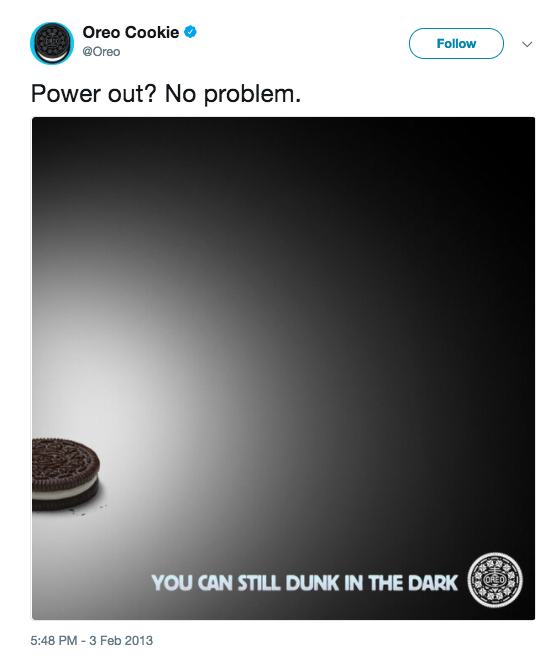In marketing, timing is everything. You want to catch buyers in the moments that will impact their purchasing decisions. Over the past few years, we’ve witnessed the rise of real-time marketing—marketing that’s aimed at customers in the moment they’re taking action, or that’s tied to trends or events. Real-time efforts range from reminder emails after a customer abandons their online shopping cart to Taco Bell’s Taco Emoji Engine, which sends taco GIFs to anyone who tweets at the brand and includes a taco emoji.
During the 2013 Super Bowl, Oreo's real-time marketing example demonstrated how powerful real-time marketing can be. The beloved cookie brand capitalized on a stadium power outage to send what is now recognized as one of the most brilliant branded tweets ever: “You can still dunk in the dark.”
Oreo’s tweet may have prompted millions of cookie lovers to think, “I could really go for an Oreo right about now.” Maybe several thousand added Oreos to their shopping list. And some customers surely followed through and actually bought the cookies on their next trip to the store. But wouldn’t it have been better if even more people had made a purchase? After all, a marketing campaign is only as good as its results. To be truly effective, Oreo needed to consider a lot more than what would make a memorable and timely tweet.
That’s where right-time marketing comes in.
As the next iteration of real-time marketing, right-time marketing focuses on refining those efforts by understanding how customers behave. In other words, it’s more than just a reminder you send in response to an abandoned cart or an offer you create around a cultural or social event. It’s a more robust approach; it uses data to fill in the blanks about who to target, why you’re marketing to them, and what the best strategy for reaching them is. It’s timeliness coupled with empiricism—a recipe for better results.
If you’re like most results-driven marketers, you’re probably ready to jump on board. Who doesn’t want increased conversion? But if you’re a smaller business, you may not know where to start. Here are some key tips for trying right-time marketing for the first time.
Focus on resonance—not just relevance
Right-time marketing requires understanding a much broader set of information: context. To effectively execute right-time marketing, you need to understand that your marketing efforts don’t happen in a vacuum. You need to identify:
- The right person: who are you trying to convert? First-time customers? Repeat clients? How much does this person usually spend with you? Are they an influencer or a high-value customer?
- The right channel: How will you reach out to the right person? Do they prefer to purchase in a brick-and-mortar shop or via an online store? Do they contact you via email or on social media?
- The right moment: Is the right person responding to a coupon or discount? Have they recently made a similar purchase?
Asking these questions will help you ensure that your marketing efforts aren’t just timely but that they actually work. By mapping out the customer journey and analyzing their behaviors, you increase the likelihood that you’ll catch them at a truly opportune moment. But these questions aren’t a comprehensive list. You have to keep asking: what data will enhance my marketing efforts? What am I missing? Don’t settle for relevancy; do your best to truly resonate with customers by understanding them more deeply.
Connect with consumers where they live: social media
One of the strongest components of a right-time marketing strategy is social media. The reality is that consumers live on platforms like Facebook and Twitter, so meeting them where they are by leveraging those platforms is crucial. But for small businesses with lean staff and budgets, social media is often the hardest part of the marketing equation to crack.
If you’re new to social media marketing, here are some tips to get you started:
Build a presence
Before you can even think about reaching individual customers on social, you need to establish a presence. You need to look credible, too; if you have a Twitter profile but have only tweeted twice in the past year, no one will take you seriously. And consider the message you send on those platforms. Are you posting mostly promotional messages? If so, consider reorienting your approach—people will quickly unfollow you (or not follow you to begin with) if all they see from you is the social media equivalent of junk mail. Scheduling tools like HootSuite and Buffer can help you curate a rotation of solid social media content, so your feeds are never empty.
Craft a personality
Is your brand’s social media presence informative? Friendly? Helpful? Funny? Think about how you want your business to be perceived and work to make your social presence reflect those qualities.
Be flexible
Oftentimes, the “right time” element of right-time marketing is something you can’t meticulously plan for. According to Marketo, nearly half of consumers think brands need to respond to their questions within an hour—regardless of the day or time. Social media is a burgeoning source for customer support inquiries, so effectively monitoring, triaging, and responding to those requests is key. But being flexible isn’t limited to responding to unhappy customers; social media is by nature dynamic, so it’s also important to keep abreast of social media trends and leverage them effectively by actively participating.
Technology is your friend
Of course, identifying all these moving pieces requires a lot of data. You probably already have most of it in your CRM, e-commerce app, or marketing automation platform. But it can still be difficult to get a bird’s eye view of your customers because the data is contained in so many different apps. And parsing through data can feel overwhelming—after all, the average small business owner isn’t a data scientist.
Technology has leveled the playing field, however; it can be a great help in accessing data and piecing it together into a 360-degree customer view.
For example, Australia’s version of Edible Arrangements wanted to use right-time marketing to capitalize on repeat customers. They realized that many of their customers send their products as gifts for birthdays or other annual events, like anniversaries. In order to remind them to buy again, the business decided to send an email to customers on a yearly basis, 10 days before the actual event that they had made a purchase for the previous year.
To do this, they needed to harness purchase data from their e-commerce platform to create tailored emails in their email marketing tool. But that process was incredibly tedious to do manually every single day, so the company used Workato’s intelligent integration and automation platform to create automatic daily campaigns on a timer. Every day, the automation searches the e-commerce platform for all the customers who made a purchase one year and ten days ago. The automation then moves those customers into a new email marketing campaign, and it sends out the email asking if they want to purchase again for their special event. Eight days later—two days before the anniversary or birthday—the automation sends a follow-up email.
From this one automation alone, the company saw an ROI of 900 percent in just a few weeks. Not only does it allow them to cultivate repeat business with appropriately targeted email campaigns, but it also gives them a way to growth hack recurring events and loyalty marketing.
Without modern, user-friendly integration technology, their right-time marketing efforts wouldn’t have been feasible. Likewise, integration can help any business effortlessly push data into wherever they need it. And next-generation analytics programs—like Salesforce’s Wave—can help you parse that data, even if you don’t have a statistics degree. As long as you have an inquisitive mind and the right tech, now is the right time to get started with right-time marketing.
Hannah Herman is the Content and Social Media Associate for Workato, an intelligent automation platform. Prior to her time there, she dabbled in many fields, but writing has always been her first love. Her other favorite things include ballet, the Oxford comma, and cheese. She currently lives in Brooklyn. You can read more of her work here.




